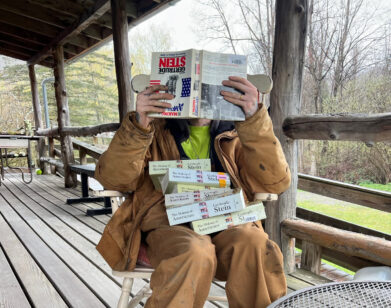Catherine Banner’s Imaginary Paradise

ABOVE: CATHERINE BANNER. PHOTO COURTESY OF PHILIP HUNTON.
When Amedeo Esposito, the only doctor on the remote Italian island of Castellamare, delivers his illegitimate son on the same night that his first legitimate child is born, an utterly riveting, tragic, and triumphant tale is set into motion.
Out today, The House at the Edge of Night (Random House) is a gorgeous, sweeping story set over four generations. Written by 28-year-old British author Catherine Banner, the novel calls to mind Captain Corelli’s Mandolin and Beautiful Ruins. It is not just the protagonists and their struggles that make Banner’s narrative incredible, but also the smaller, secondary characters that add color and detail, and the intricately described island of Castellamare itself.
Originally from Cambridge, Banner now lives in Turin with her husband. While The House at the Edge of Night is her first book aimed at adults, Banner signed with her first literary agent over 12 years ago at the ripe age of 16 and has already published a trilogy of YA novels.
JEFF VASISHTA: There are lots of small details and characters that illuminate the novel, like Concetta and her epilepsy. Where did these characters come from?
CATHERINE BANNER: From the beginning, I wanted to write about the small town, that particular network which can be both accepting and narrow-minded, both gossipy and big-hearted. It’s a setting that American writers have traditionally explored more than European writers. What I believe is most interesting about the small community is the way the individual navigates it. Growing up on a small island as a child simultaneously restricts you and makes you larger than life, the only one of your kind—if you’re good at singing, you’re the only singer, if you’re good at painting, the only painter, but if you suffer humiliation or judgment it can be hard to live it down. So I wanted to show Concetta to be in a position of disadvantage because of her seizures, put in the place of the “invalid child” in the community’s imagination, in order to tell the story of how she overcomes this to become one of the most self-reliant characters in the book. What I always want is for my characters to be simultaneously complex and fathomable. Over the course of the book, I was trying to hold each character up to the light from different angles in a way that would illuminate them and complicate them at the same time. This could be in a moral sense—for example I wanted il conte, a great Fascist and sometimes a bully, also to be one of the characters with which the reader sympathizes the most. Milan Kundera wrote that the novel should be an “imaginary paradise” where “no one possesses the truth… but everyone has the right to be understood.” That’s what I feel the narrator’s role is, in a way: to keep complicating the characters until they come to life on the page and win the reader’s sympathy.
VASISHTA: You’ve written YA novels before this. Why did you decide that now was the time to write this novel and how did it differ in language and tone and process from writing for young adults?
BANNER: The strange thing is that I didn’t really expect to write this novel at all. I was taking a break from writing when I had the idea for The House at the Edge of Night, and at the time I honestly thought that break might become permanent. I’d started writing so young that I felt I needed more time to determine whether I was going to remain a writer, and whether I had other stories to tell. So I had moved from my hometown in the South to the Northeast of England, and was working as a teacher. But the 2008 financial crisis and the beginning of the great recession were very present realities at that time in small European places, and gradually, I became convinced that there were important stories here that weren’t being told.
VASISHTA: This novel is so well structured and written. Do you have a method for plotting and planning?
BANNER: The structure was actually one of the hardest parts of the process for me, so I’m pleased that in some way that was successful. I began writing so young that I think somewhere along the way I underwent a shift, as all writers who continue writing beyond adolescence probably do, from thinking “What story shall I write?” to asking, instead, the more pertinent question, the one which can sustain a lifetime of work: “How can I do justice to this story I feel I must tell?” I approached The House at the Edge of Night very differently to the novels I wrote when I was a teenager. When I was first a writer, I worked by trial and error—I worked very much by instinct, and thought nothing of throwing away 50,000 or 100,000 words if the work wasn’t right and just starting again. When I came back to writing, I was attempting a very different kind of book and so I approached the work very differently. I kept painstaking records and approached it slowly, in quite a scientific way. I felt I owed that to the story. For example, I kept writing notebooks where I recorded every detail of the process. And I did about four months of research before I even began writing, during which time I also worked out an outline of the book, adjusting the shape of the story until I felt it had the right distribution of light and shade. All the writers I love have one great quality: they are able to switch back between comedy and tragedy in the way that real life does, without belittling either, and that was one of the hardest and most fundamental things to get right in a story of this kind.
VASISHTA: How has living in Turin Italy influenced your writing and your life?
BANNER: It’s interesting, because for the first time I’m writing about somewhere I currently live. So in terms of research it’s much easier, and in terms of maintaining the imaginative distance you need to recreate a place on the page, it’s much harder. Moving to Turin has felt like a great gift for my work, though, because the fact that my husband was offered work here was quite random, and yet after finishing The House at the Edge of Night I had had an idea in the back of my mind for almost a year that the mountains of North Italy were exactly the place I wanted to write about next. I can’t explain that, but I’m grateful for it! In terms of my personal life, living in Italy has given me some distance on my own country of birth properly for the first time, which is a valuable insight for a writer. For the first time, Britain looks noticeably British to me when I return, and moving between the two has given me an odd insider-outsider perspective, which I think is a good position to occupy.
VASISHTA: After living in Rome, Jhumpa Lahiri wrote a non-fiction book in Italian. Do you find your inner voice changing now?
BANNER: I was fascinated to read Jhumpa Lahiri’s book, in both languages, because she’s one of the only other writers I know who writes on the boundary between Italian and English. But I think to write in a language which is not your own is just extraordinary. Although I’m fluent in spoken Italian, I can’t imagine writing in Italian myself—I think it’s rare for a writer to be able to master a second language so completely as to be able to create more interesting work in it than in their first language, something which Lahiri acknowledges even in her incredibly accomplished book. But of course I live in Italian in a practical, everyday sense, more so perhaps than Lahiri who seems to have chosen Italian rather than being thrown into it as I was, and that dynamic affects my work. The territory in which I write—researching in Italian and writing in English—is relatively uncharted, and although that can be difficult in practical terms, working on any kind of boundary is a great opportunity for a writer.
VASISHTA: With the Brexit vote has your desire to live in England diminished?
BANNER: The main feeling I have is one of sadness. What I find so sad is that my desire to live in the Britain I grew up in is just the same as ever. That Britain—the Britain I remember—is multicultural, open, and tolerant. The street where I grew up had churches, international shops from twenty different countries, a synagogue, a mosque. Of my group of friends in secondary school, I was the only person who was not bi- or trilingual. When I tell people I’m British, that’s what, to me, “British” signifies. But now I see that to many people it means something quite different. So what has diminished as a result of this vote is my wish to live in the Britain that I see my home country becoming—a place I don’t recognize, where racism, intolerance, and xenophobia are much closer to the surface than I had thought. As a writer, I’m genuinely torn now between turning from my home country in sadness and engaging with it, lending my voice in some way. Of course, engagement is the only possible approach, and as writers we can’t absent ourselves from the debates that surround us, however painful they are.
THE HOUSE AT THE EDGE OF NIGHT IS OUT TODAY, JULY 12, 2016.






